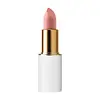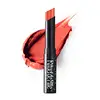What's inside
What's inside
 Key Ingredients
Key Ingredients

 Benefits
Benefits

 Concerns
Concerns

 Ingredients Side-by-side
Ingredients Side-by-side

Caprylic/Capric Triglyceride
MaskingSimmondsia Chinensis Seed Oil
EmollientCera Alba
EmollientMica
Cosmetic ColorantEuphorbia Cerifera Wax
Copernicia Cerifera Wax
Sambucus Nigra Fruit Extract
AstringentDipalmitoyl Hydroxyproline
Skin ConditioningEuterpe Oleracea Sterols
Skin ConditioningHydrogenated Castor Oil
EmollientJojoba Esters
EmollientShorea Robusta Resin
TonicSpirulina Platensis Extract
Skin ProtectingTrehalose
HumectantHelianthus Annuus Seed Wax
Skin ConditioningHelianthus Annuus Seed Oil
EmollientSodium Hyaluronate
HumectantSilica
AbrasiveVanilla Planifolia Fruit Extract
Skin ConditioningTocopherol
AntioxidantRicinus Communis Seed Oil
MaskingBeta-Sitosterol
Emulsion StabilisingAcacia Decurrens Flower Wax
EmollientPolyglycerin-3
HumectantSqualene
EmollientLinoleic Acid
CleansingOleic Acid
EmollientLinolenic Acid
CleansingCI 75470
Cosmetic ColorantCI 77891
Cosmetic ColorantCI 77499
Cosmetic ColorantCI 77491
Cosmetic ColorantCaprylic/Capric Triglyceride, Simmondsia Chinensis Seed Oil, Cera Alba, Mica, Euphorbia Cerifera Wax, Copernicia Cerifera Wax, Sambucus Nigra Fruit Extract, Dipalmitoyl Hydroxyproline, Euterpe Oleracea Sterols, Hydrogenated Castor Oil, Jojoba Esters, Shorea Robusta Resin, Spirulina Platensis Extract, Trehalose, Helianthus Annuus Seed Wax, Helianthus Annuus Seed Oil, Sodium Hyaluronate, Silica, Vanilla Planifolia Fruit Extract, Tocopherol, Ricinus Communis Seed Oil, Beta-Sitosterol, Acacia Decurrens Flower Wax, Polyglycerin-3, Squalene, Linoleic Acid, Oleic Acid, Linolenic Acid, CI 75470, CI 77891, CI 77499, CI 77491
Ricinus Communis Seed Oil
MaskingSimmondsia Chinensis Seed Oil
EmollientEuphorbia Cerifera Wax
Silica
AbrasiveCera Alba
EmollientCopernicia Cerifera Wax
Titanium Dioxide
Cosmetic ColorantCI 75470
Cosmetic ColorantCI 77491
Cosmetic ColorantCI 77492
Cosmetic ColorantRosmarinus Officinalis Leaf Extract
AntimicrobialHelianthus Annuus Seed Oil
EmollientLavandula Angustifolia Oil
MaskingTocopherol
AntioxidantMica
Cosmetic ColorantIron Oxides
Zinc Oxide
Cosmetic ColorantCI 77891
Cosmetic ColorantBixa Orellana Seed
AntioxidantCI 77400
Cosmetic ColorantCalcium Sodium Borosilicate
Tin Oxide
AbrasiveAluminum Hydroxide
EmollientStearic Acid
CleansingRicinus Communis Seed Oil, Simmondsia Chinensis Seed Oil, Euphorbia Cerifera Wax, Silica, Cera Alba, Copernicia Cerifera Wax, Titanium Dioxide, CI 75470, CI 77491, CI 77492, Rosmarinus Officinalis Leaf Extract, Helianthus Annuus Seed Oil, Lavandula Angustifolia Oil, Tocopherol, Mica, Iron Oxides, Zinc Oxide, CI 77891, Bixa Orellana Seed, CI 77400, Calcium Sodium Borosilicate, Tin Oxide, Aluminum Hydroxide, Stearic Acid
Ingredients Explained
These ingredients are found in both products.
Ingredients higher up in an ingredient list are typically present in a larger amount.
Cera alba is beeswax, or the wax used by bees to make honeycombs. It is a texture-enhancer and emollient. A study from 2003 found beeswax to be a stronger emollient than ingredients such as petroleum jelly.
As an emollient, beeswax helps hydrate the skin by creating a barrier on top. This barrier traps moisture in.
Emulsifiers help prevent ingredients from separating. This helps create consistent texture.
The structure of beeswax is mainly long-chain alcohols and the esters of fatty acids.
There are three types of beeswax: yellow, white, and absolute. Yellow is pure beeswax taken from the honeycomb. White beeswax is created by filtering or bleaching yellow beeswax. Absolute beeswax is created by treating beeswax with alcohol. Beeswax used in cosmetics are purified.
Beeswax has been used throughout history and even in prehistoric times. Some common uses for beeswax still used today are making candles, as a waterproofing agent, and polish for leather.
Learn more about Cera AlbaCi 75470 is a bright-red pigment. It is AKA carmine.
Carmine is derived from insects such as the cochineal beetle. This ingredient has been used as a natural dye for over 2000 years.
Ci 77491 is also hydrated iron III oxide. It's sole purpose is to give a red/pink hue to products.
Iron III oxides are classified as inorganic chemicals for coloring.
Synthetically created Ci 77491 is considered safer than those naturally found. This is because the synthetically created version may contain less impurities. Iron oxides are generally non-toxic and non-allergenic.
Learn more about CI 77491Ci 77891 is a white pigment from Titanium dioxide. It is naturally found in minerals such as rutile and ilmenite.
It's main function is to add a white color to cosmetics. It can also be mixed with other colors to create different shades.
Ci 77891 is commonly found in sunscreens due to its ability to block UV rays.
Learn more about CI 77891Copernicia Cerifera Wax comes from a palm tree native to Brazil; another name for this ingredient is Carnauba Wax.
This ingredient is used to thicken texture and also leaves behind a film when applied.
Fun fact: This wax has the highest melting point of all natural waxes and low solubility.
Learn more about Copernicia Cerifera WaxHelianthus Annuus Seed Oil is the oil derived from the seeds of a Sunflower. Sunflower seed oil is non-fragrant. It is an emollient, meaning it helps to soften the skin.
Sunflower seed oil contains many fatty acids. The fatty acids found in sunflower seeds include (from highest amount to least): linoleic acid, myristic acid, palmitic acid, stearic acid, arachidic acid, oleic acid, and linolenic acid.
These fatty acids help the skin create ceramides. Ceramides play a role in repairing the skin barrier.
Helianthus Annuus Seed Oil helps moisturize the skin. This in turn helps the skin look more rejuvenated and smoother.
Sunflowers are rich in vitamin E.
Historians believe Indigenous cultures of North America domesticated sunflowers before corn. Thus they relied on sunflower oil for a variety of uses. One such use is moisturizing skin and hair.
Sunflower seed oil may not be fungal acne safe. We recommend speaking with a professional if you have any concerns.
Learn more about Helianthus Annuus Seed OilMica is a naturally occurring mineral used to add shimmer and color in cosmetics. It can also help improve the texture of a product or give it an opaque, white/silver color.
Serecite is the name for very fine but ragged grains of mica.
This ingredient is often coated with metal oxides like titanium dioxide. Trace amounts of heavy metals may be found in mica, but these metals are not harmful in our personal products.
Mica has been used since prehistoric times throughout the world. Ancient Egyptian, Indian, Greek, Roman, Aztec, and Chinese civilizations have used mica.
Learn more about MicaRicinus Communis Seed Oil is the INCI name for castor oil.
Castor Oil helps moisturize the skin. It is rich in a fatty acid called ricinoleic acid. This fatty acid helps prevent moisture loss on the skin. This helps keep your skin soft and hydrated. Ricinoleic acid also has anti-inflammatory and pain reducing properties.
Besides hydrating the skin, castor oil is also used to hydrate hair. By keeping the hair shaft moisturized, breakage is decreased. More studies are needed to show castor oil's effective on stimulating hair growth.
Castor oil is created by cold-pressing castor seeds and then purifying the oil with heat. It was used in Ancient Egypt as fuel in lamps and to help treat eye irritation.
The term 'fragrance' is not regulated in many countries. In many cases, it is up to the brand to define this term. For instance, many brands choose to label themselves as "fragrance-free" because they are not using synthetic fragrances. However, their products may still contain ingredients such as essential oils that are considered a fragrance.
Learn more about Ricinus Communis Seed OilSilica, also known as silicon dioxide, is a naturally occurring mineral. It is used as a fine, spherical, and porous powder in cosmetics.
Though it has exfoliant properties, the function of silica varies depending on the product.
The unique structure of silica enhances the spreadability and adds smoothness, making it a great texture enhancer.
It is also used as an active carrier, emulsifier, and mattifier due to its ability to absorb excess oil.
In some products, tiny microneedles called spicules are made from silica or hydrolyzed sponge. When you rub them in, they lightly polish away dead skin layers and enhance the penetration of active ingredients.
Learn more about SilicaThis oil comes from the seeds of the desert shrub called Jojoba. It is more commonly known as jojoba oil, a non-comedogenic oil.
Jojoba oil does not contain fragrance and has many fatty-acids, making it a great soothing ingredient.
It also contains Vitamin E, a great moisturizing ingredient. Vitamin E is also an antioxidant and protects your skin against oxidative damage.
This ingredient humectant properties, meaning it helps draw moisture from the air. This helps keep your skin hydrated.
While jojoba has antibacterial properties, it is only able to kill some strains of bacteria.
Studies also show it helps in wound healing. In fact, Indigenous cultures have used jojoba as a moisturizer and to help treat burns for centuries.
Fun fact: Jojoba oil similar to natural human skin sebum, so it has a great effect on dry skin. It is also promising with helping to regulate sebum production.
Due to its fatty acid content, Jojoba oil may not be fungal acne safe. We recommend speaking with a professional if you have any concerns.
Learn more about Simmondsia Chinensis Seed OilTocopherol (also known as Vitamin E) is a common antioxidant used to help protect the skin from free-radicals and strengthen the skin barrier. It's also fat soluble - this means our skin is great at absorbing it.
Vitamin E also helps keep your natural skin lipids healthy. Your lipid skin barrier naturally consists of lipids, ceramides, and fatty acids. Vitamin E offers extra protection for your skin’s lipid barrier, keeping your skin healthy and nourished.
Another benefit is a bit of UV protection. Vitamin E helps reduce the damage caused by UVB rays. (It should not replace your sunscreen). Combining it with Vitamin C can decrease sunburned cells and hyperpigmentation after UV exposure.
You might have noticed Vitamin E + C often paired together. This is because it is great at stabilizing Vitamin C. Using the two together helps increase the effectiveness of both ingredients.
There are often claims that Vitamin E can reduce/prevent scarring, but these claims haven't been confirmed by scientific research.
Learn more about TocopherolEuphorbia Cerifera wax comes from a shrub in Northern Mexico. It is used to stabilize formulations and has emollient properties.
Emollients form a thin layer on top of skin to prevent water from evaporating, keeping skin and lips hydrated.
According to a manufacturer, this wax can range from a yellow/brown color to translucent.
Learn more about Euphorbia Cerifera Wax